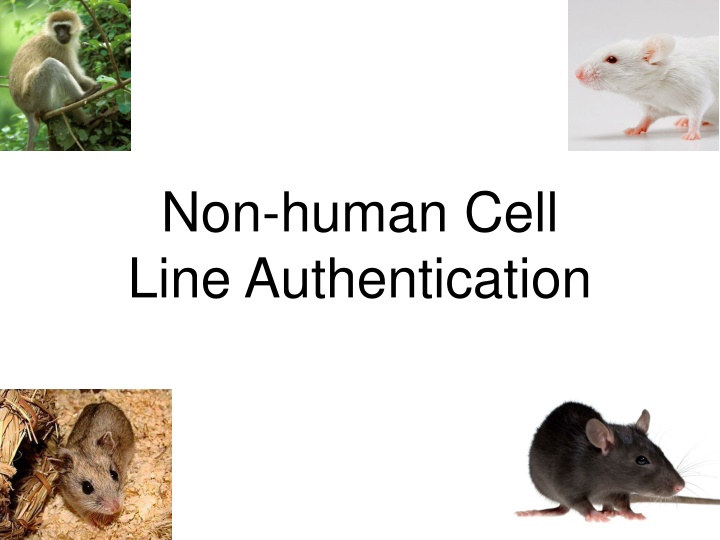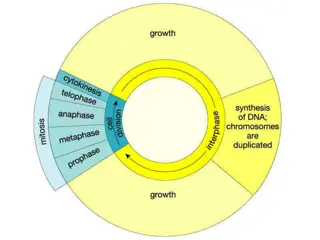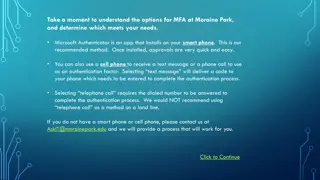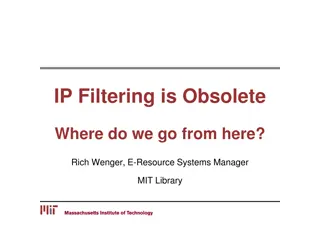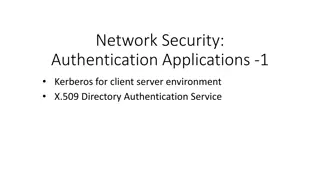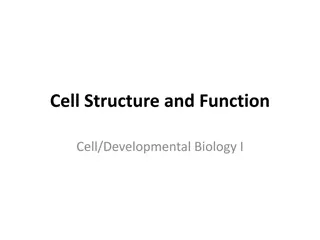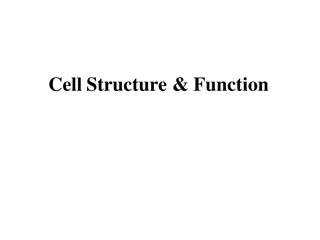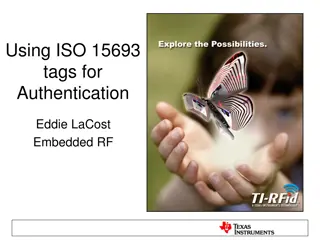Methods of Non-Human Cell Line Authentication and Identification
Techniques such as chromosomal karyotyping, DNA barcoding, and STR genotyping are used for authenticating and identifying non-human cell lines to ensure accurate research outcomes. Species-level identification, karyotyping, and commercial services for mouse and rat cell lines are discussed, highlighting the importance of maintaining authenticity in cell line studies.
Download Presentation

Please find below an Image/Link to download the presentation.
The content on the website is provided AS IS for your information and personal use only. It may not be sold, licensed, or shared on other websites without obtaining consent from the author.If you encounter any issues during the download, it is possible that the publisher has removed the file from their server.
You are allowed to download the files provided on this website for personal or commercial use, subject to the condition that they are used lawfully. All files are the property of their respective owners.
The content on the website is provided AS IS for your information and personal use only. It may not be sold, licensed, or shared on other websites without obtaining consent from the author.
E N D
Presentation Transcript
Non-human Cell Line Authentication
Methods to Authenticate Non-human Cells Identification Contamination testing Chromosomal karyotype Protein expression
Identity Testing of Non-human Cell Lines Species-level identification Karyotyping DNA barcoding Public database available Standard methods in place Multiplex PCR using species-specific primers Individual level identification Short Tandem Repeat (STR) genotyping Commercial services available for mouse Public database available (limited # entries) Standard methods not currently available Commercial services available for rat (strain level identification only)
Karyotyping The counting of modal chromosome number and observing specific chromosomal markers of viable cells during metaphase. Each species has a unique chromosomal karyotype characterized by the size, shape, and number of chromosomes. Attention is paid to Length Position of the centromeres Banding pattern Any notable differences between the sex chromosomes Any other physical characteristics www.pathology.washington.edu/galleries/cytogallery
Karyotyping Cell Lines Each species has a unique karyotype Species ID Chromosomal rearrangements Index of genomic stability www.coriell.org/research-services/cytogenetics/karyotyping
DNA Barcoding A DNA based approach that is used to identify vertebrate and invertebrate animal cells at the species level. This method targets 648 bp of the 5 region of the mitochondrial cytochrome c oxidase subunit 1 (CO1 or COX1) gene. The target sequence is compared to a reference library of sequences to determine the species of the sample in question. Human Mitochondrial Genome Picturecreated by Emmanuel Douzery Written consensus standard for DNA Barcoding: Designation: ASN-0003 (published in 2015) Species-Level Identification of Animal Cells through Mitochondrial Cytochrome c Oxidase Subunit 1 (CO1) DNA Barcodes
DNA Barcoding Flow Chart ANSI/ASN-0003-2015 Primers used to amplify the 648 bp CO1 barcode region are shown in the table below. Degenerate universal primers (VF1d and VR1d) are used as sequencing primers. LepF1 and LepR1 primers are used for insect cell lines. R = purines (A/G) Y = pyrimidines (T/C) Primers are tailed with M13 sequence (commonly used sequencing primers)
DNA Barcoding - Databases Barcode of Life Data Systems (BOLD) The reference database contains verified sequences derived from voucher (reference) specimens. Such authenticated cultures/tissues can serve as standard reference materials or as controls of authenticated animal cells for tissue culture, regulatory, and taxonomic applications. GenBank (no voucher specimens) To meet BARCODE standards in GenBank, records must contain: Complete species name Unique identifier for voucher specimen (archived in museum or biological repository) Country of origin Primer sequences used Bi-directional high-quality sequencing trace files (cover at least 75% of CO1 barcode region)
DNA Barcoding - Limitations Some closely related species cannot be readily distinguished Rates of evolution of mitochondrial genes may vary between species, which can lead to overlap of species variation This method is unable to resolve cell lines from different individuals within the same species DNA barcoding may or may not flag samples that are mixtures of two different species This is a useful method to determine species-level identification: Simple Rapid Inexpensive Adapted for high throughput analysis Importantly, universal primers are used (other methods rely on specific primers for specific species)
Species-Specific Multiplex PCR Primers An ATCC SDO working group is currently working on a written consensus standard for this method (ANSI/ASN-0004) The assay described by Cooper et al. covers 14 of the most common species found in tissue culture Primers are based on mitochondrial cytochrome c oxidase 1 (CO1) and cytochrome b genes Tests for cross contamination of other species Visualize PCR products using gel electrophoresis where amplicon size is species-specific
Species-Specific Multiplex Primers Limitations Only capable of detecting species that are represented in the primer multiplex (14). Is unable to discriminate between cell lines from the same species (ex: 2 different mouse cell lines) This is an easy method to determine species-level identification: Fast (same day results) Inexpensive Easily shows contamination of cell lines from different species Any lab equipped with a thermal cycler and gel electrophoresis apparatus can perform this assay
Identification at the Individual Level STR genotyping Simple repeats Di (CACACA) Tri (CATCAT) Tetra (CATGCATG) Penta (CATGACATGA) Complex repeats (CATG)R(TA)(TAGA) [GATA]8 =
STR Genotyping Services Human Written consensus standard Commercial services available Public Databases Commercial kits Mouse Commercial services available Mouse Cell Line Authentication Consortium Validated 18 mouse STR markers Public database (NCBI BioSample and Cellosaurus) Allelic ladder development (in progress) Written consensus standard (needed) Rat Commercial service available for rat using STR markers Identity of rat strain only, not individual resolution
Limitations of STR genotyping Cell lines that are derived from the same parent line will most likely have matching STR genotypes (they are from the same individual) Inter-species contamination will not be detected
Summary How to authenticate non-human cell lines? Identity testing is a part of authentication Species-level identification Karyotyping DNA barcoding Species-specific multiplex PCR Individual level identification STR genotyping Human Mouse Rat Authentication involves fully characterizing the cell line (morphology, mycoplasma testing, protein expression, genomic stability)
